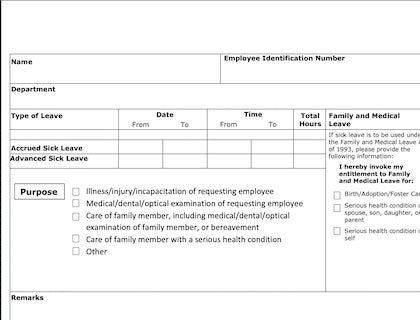
Sick Leave Request Form PDF Download:
Download a free sick leave request form template in PDF format and start using it right away.
Download NowThe U.S. Family and Medical Leave Act:
The only labor law governing public and private sector medical leave in the U.S. is the Family and Medical Leave Act (FMLA) of 1993. This act applies to companies with more than 50 employees who live within 75 miles of their workplace.
According to the terms of the act, employees are entitled to take job-protected and unpaid leave for specified medical and family reasons. During their leave, employees benefit from the continuation of health insurance coverage and job security as if they had not taken any leave.
Employees are eligible for FMLA leave if they have worked for the company for a minimum of 12 months and completed at least 1,250 hours of work. If eligible, employees may take:
12 weeks of leave in a 12-month period for:
- The birth of a child, or to care for a child within the first year of its birth.
- Placement of a child for adoption or foster care, and to care for the child within the first year of placement.
- Any serious health conditions that result in the employee being unable to perform the functions of his or her job.
- To address qualifying exigencies arising from a family member's active duty.
26 weeks of leave in a 12-month period:
- To care for a family service member recovering from a serious injury or illness.
Sick Leave for Federal Contractors:
In 2016, the U.S. Department of Labor published a rule to implement Executive Order 13706.
The rule requires that companies entering into contracts with the federal government must provide covered employees with up to 7 days of paid sick leave annually. This includes paid leave for the care of a family member.
The Benefits of Providing Sick Leave:
- Healthy employees are more productive during working hours.
- Employees with paid sick leave are less likely to be injured on the job.
- Employees who are sick may choose to stay at home, preventing contagions from spreading in the workplace.
- Employees with paid sick leave are more likely to utilize preventative screening and health services.
- Employees with paid sick leave are less likely to delay treatment for themselves or a family member.
- Having a paid sick leave policy encourages new hires.
Which States Require Paid Sick Leave?
As of 2022, sixteen states and Washington DC have passed legislation to provide employees with paid sick leave, with eligibility requirements varying by state. New Mexico is the most recent state to pass legislation that will come into effect in July 2022. The following table shows the state and number of leave hours allocated:
States that Require Paid Sick Leave:
State | Paid Sick Time |
|---|---|
Arizona | 1 hour of paid leave for every 30 hours worked capped at 24 or 40 hours per year. |
California | 1 hour of paid leave for every 30 hours worked capped at 48 hours per year. |
Colorado | 1 hour of paid leave for every 30 hours worked capped at 48 hours per year. |
Connecticut | 1 hour of paid leave for every 40 hours worked capped at 40 hours per year. |
Maine | 1 hour of paid leave for every 40 hours worked capped at 40 hours per year. |
Maryland | 1 hour of paid leave for every 30 hours worked capped at 40 hours per year. |
Massachusetts | 1 hour of paid leave for every 30 hours worked capped at 40 hours per year. |
Michigan | 1 hour of paid leave for every 30 hours worked capped at 40 or 72 hours per year. |
Nevada | 0.01923 hours of paid leave for every hour worked capped at 40 hours per year. |
New Jersey | 1 hour of paid leave for every 30 hours worked capped at 40 hours per year. |
New Mexico (effective July 1, 2022) | 1 hour of paid leave for every 30 hours worked capped at 64 hours per year. |
New York | 1 hour for every 30 hours worked capped at 40 or 56 hours per year. |
Oregon | 1 hour of paid leave for every 30 hours worked capped at 40 hours per year. |
Rhode Island | 1 hour of paid leave for every 35 hours worked capped at 40 hours per year. |
Vermont | 1 hour of paid leave for every 52 hours worked capped at 40 hours per year. |
Washington | 1 hour of paid leave for every 30 hours worked with no annual cap. |
Washington DC | 1 hour of paid leave for every 37, 43, or 87 hours worked capped at 56, 40, or 24 hours per year. |
Implementing a Paid Sick Leave Policy:
In states with paid sick leave laws, employers may provide their own sick leave policies, providing the policy exceeds the protections provided by the state. For example, when the law stipulates that employers must provide 1 hour of paid sick leave for every 30 hours worked, companies may provide 1.5 or 2 hours of sick leave for every 30 hours worked.
In cases where a policy was in place before state laws were passed, the policy may be grandfathered.
In states where there is no paid sick leave law, companies are free to create their own sick leave policies or choose not to provide paid sick leave. Sick leave policies must be written and provided to employees upon joining the company. Your employee paid sick leave policy should include:
- A written statement guaranteeing paid sick leave rights.
- The rate at which paid sick leave is accrued.
- The purpose for which paid sick leave may be used.
- Waiting periods, if applicable.
Waiting Periods:
Many paid sick leave laws and policies include waiting periods from the time when the employee first joins the company. For example, some states require that employees work a minimum of 680 days for the company before they can take paid sick leave.
Companies may choose to implement a waiting period if there is no law stating otherwise.
Front-Load Leave:
In some states, employers may choose to front-load sick leave for employees as opposed to the accrual method. This method provides employees with their full number of paid sick days at the start of the calendar year. Leave hours are then subtracted from the total as taken.
Sick Leave For Part-Time Workers:
All employees, both full-time and part-time are subject to the same state-regulated paid sick leave laws. As long as part-time employees have worked the minimum number of hours for the company, they are entitled to paid sick leave.
In states where no sick leave law is in place, companies may choose not to provide paid sick leave for part-time employees.
How to Calculate Sick Leave Accrual?
If your company is based in a state or a city with paid sick leave laws, you are required to provide your employees with the minimum number of accrued hours of sick leave stipulated. In most cases, paid sick leave only applies to companies with 15 or more employees. Paid sick leave can be accrued or given up-front at the beginning of the year.
The total number of sick days that can be accrued differs depending on the state or city law. In most cases, sick leave is accrued at 1 hour per 30 hours worked and capped at a total of 40 hours per year. This equates to one full day of sick leave for every six weeks worked. To calculate sick leave accrual:
- Add up the total number of hours the employee has worked in the current sick leave year cycle.
- For every 30 hours worked, add 1 hour of paid sick leave.
- Subtract the number of hours of paid sick leave already used in the current cycle.
Unused Sick Leave:
Most states with paid sick leave laws require employers to carry over sick leave days or pay out employees for unused leave. The number of days that can be carried over may differ as does the number of unused days being paid out.
In states with no paid leave laws, employers may institute a paid leave policy where unused days are not carried over or paid out.
Medical Certificates:
To prevent the abuse of paid sick leave, some employers require their employees to provide a medical certificate from a registered physician stipulating the reason for their time off.
This is not a formal requirement for state-mandated sick leave and is only relevant for cases where employees have taken time off to attend to a medical condition. Medical certificates are only required when an employee has taken more than two consecutive days off.
The Healthy Families Act:
In January of 2015, President Barack Obama asked Congress to pass the Healthy Families Act. The act was introduced in the Senate on the 14th of March 2019 and has yet to be passed.
If successful, the Healthy Families Act would require all U.S. employers with more than 15 employees to provide a minimum of 1 hour of paid sick leave for every 30 hours worked, up to a maximum of 56 hours of paid leave in a calendar year.
Companies with fewer than 15 employees would have the option of providing the same paid leave or opting out of the requirement. In such cases, employers must provide employees with a minimum of 56 hours of unpaid leave per calendar year.
According to the terms of the act, an employee may use paid sick leave for absences resulting from:
- Any physical or mental illness, injury, or medical condition.
- Obtaining medical diagnosis, care, or preventative medical care.
- To care for a family member, domestic partner, or close relative.
- Absence resulting from sexual assault, stalking, or domestic violence.

